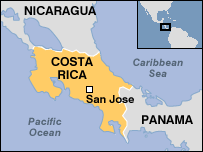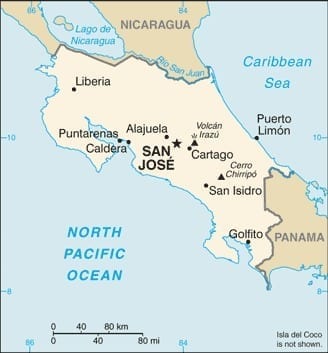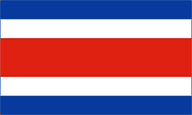Official Name: Republic of Costa Rica
Internet Domain: .cr
International Dialing Code: +506
Time Zone: UTC-6
Location and Size
Area: 51,100 sq. km (19,730 sq. mi.) ” approximately the size of the states of Vermont and New Hampshire combined.
Government
Democratic republic with a very strong system of constitutional checks and balances. The branches of government are as follows:
- Executive: President Oscar ARIAS Sanchez, two vice presidents, Cabinet
- Legislative: 57-deputy unicameral congress
- Judicial: Supreme Court of Justice
Legal System
Based on Spanish civil law system. Has accepted compulsory International Court of Justice (ICJ) jurisdiction. (What does this mean?)
People
Unlike many other Central American countries, Costa Ricans are largely of European descent with Spain being the primary country of origin. The indigenous population numbers less than 1% of the population. An estimated 10 -15% is Nicaraguan, of fairly recent arrival and primarily of Spanish-Native origin. Descendants of 19th-century Jamaican immigrant workers constitute an English-speaking minority.
- Population: 4,987,142 (2018 est.)
- Population growth rate: 1.13% (2018 est.)
- Languages: Spanish (official), English
- Literacy: 97.8% (2015 census)
- Ethnic Make-up: White (including mestizo) 94%, black 3%, Amerindian 1%, Chinese 1%, other 1%
- Religions: Catholic 76.3%, Evangelical 13.7%, Jehovah’s Witnesses 1.3%, other Protestant 0.7%, other 4.8%, none 3.2%

Economy
Compared with its Central American neighbors, Costa Rica has achieved a high standard of living. Its citizens enjoy one of the highest life expectancy levels in the Western hemisphere and better living conditions than their war-torn neighbors.
Costa Rica’s major economic resources are its fertile land and frequent rainfall, its well-educated population, and its location. Situated in the Central American isthmus, it enjoys easy access to North and South American markets and direct ocean access to Europe and Asia.
The country’s basically stable economy depends on tourism, agriculture, and electronics exports. Exports have become more diversified in the past 10 years due to the growth of the high-tech manufacturing sector, dominated by the microprocessor industry and the production of medical devices. Tourism continues to bring in foreign exchange, as Costa Rica’s impressive biodiversity makes it a key destination for ecotourism.
Reducing inflation remains a difficult problem due to rising commodity import prices and labor market rigidities, though lower oil prices will decrease upward pressures.
Currency: Colones (CRC)
Leading Markets (2017): 40.9%, Belgium 6.3%, Panama 5.6%, Netherlands 5.6%, Nicaragua 5.1%, Guatemala 5.0%
Leading Exports – Commodities: Bananas, pineapples, coffee, melons, ornamental plants, sugar; seafood; electronic components, medical equipment
Leading Suppliers (2017): US 38.1%, China 13.1%, Mexico 7.3%
Leading Imports – Commodities: Raw materials, consumer goods, capital equipment, petroleum, construction materials
Top Industries: Microprocessors, food processing, medical equipment, textiles and clothing, construction materials, fertilizer, plastic products
Top Agricultural Products: Bananas, pineapples, coffee, melons, ornamental plants, sugar, corn, rice, beans, potatoes; beef, poultry, dairy; timber
Comparative Economic Indicators 2022 (estimated)
| Costa Rica | Nicaragua | Panama | El Salvador | Guatemala | Honduras | |
| Population* (millions) | 5.20 | 6.30 | 4.3 | 6.50 | 17.70 | 9.45 |
| Population growth* (%) | 1.01% | 0.92% | 1.53% | 0.57% | 1.58% | 1.19% |
|
Literacy (%)
|
97.90%
|
82.60%
|
95.70% | 89.10% | 80.80% | 88.50% |
| GDP** (USD billions) | $100.25 | $34.98 | $104.10 | $52.26 | $141.50 | $50.89 |
| GDP per capita** (USD) | $19,700 | $5,300 | $25,400 | $8,100 | $8,400 | $5,100 |
| Economic growth (%) | ||||||
| Inflation (%) | 2.00% | 5.30% | 0.90% | 0% | 3.70% | 4.30% |
| Unemployment (%) | 8.10% | 6.40% | 6.14% | 7.00% | 2.30% | 5.60% |
| Exports (USD billions) | $21.20 | $5.34 | $20.18 | $6.29 | $13.12 | $7.16 |
| Imports (USD billions) | $19.39 | $5.94 | $17.41 | $10.82 | $19.30 | $11.50 |
| Foreign debt (% of GDP) | ||||||
| Currency | Colon (CRC) |
Cordoba Oro (NIO) |
Balboa (PAB) |
Colon (SVC) |
Quetzal (GTQ) |
Lempira (HNL) |
|
Exchange rates
(per USD on 9/23/19)
|
573.50 | 30.11 | 1.00 | 1 | 7.32 | 23.74 |
|
Exchange rates
(per EUR on 9/23/19)
|
639.79 | 37.46 | 1.12 | 9.78 | 8.58 | 27.37 |
* 2022 estimates
** PPP ” Purchasing Power Parity
*** Excluding customs-free area
Credit and Collections
Overseas Press & Consultants (OP&C) Evaluation
- Collection Experience: Fair-Good
- Exchange Delays: 3 months
- Preferred Credit Terms: Unconfirmed letter of credit
- Minimum Credit Terms: Sight draft
ABC-Amega’s collection experience in Costa Rica
Collecting in Costa Rica is time-consuming, especially if legal action is necessary. In fact, it can take years just to schedule a court date. And the judicial system requires everything to be handled in writing.
However, since May of 2008 when the government implemented a Judicial Collection law, court cases have been sped up. There is now available a “Simple Executive Trial” in which the judges can simply review relevant documentation (a promissory note, for instance), listen to both sides and then make his decision immediately. The law also implemented some changes to facilitate notification to debtors. If there is no prenda (non-possessory pledge) or lien involved, the debtor’s attorney need only be notified of any pending court dates. It becomes his responsibility to locate and inform the debtor.
Dispute Resolution
The legal process in general is often sluggish, making binding arbitration an attractive option.
Risk Assessment
Coface Country Risk Rating: B — A somewhat shaky political and economic outlook and a relatively volatile business environment can affect corporate payment behavior. Corporate default probability is still acceptable on average.
Credendo Political Risk Rating: 3 ” Mid – low risk (1 to 7 scale)
Crednedo Commercial Risk Rating: B ” Average risk (A to C scale)
Business Climate
Costa Rica remains one of the safest and most attractive countries for foreign investment in Latin America. It has consistently sought to widen its economic and trade ties within and outside its region. The stated aim is to entice primarily high-tech corporations to take advantage of Central America’s most educated, computer literate and disciplined workforce, along with the modern production infrastructure the country is currently working to create.
Costa Rica, however, faces a number of serious challenges including:
- It ranks 115th for ease of doing business out of 175 countries in the World Bank’s Doing Business Index. The difficulties of doing business there, while much less than with many other countries in the region, has hampered the flow of investment and resources needed to repair and rebuild the country’s deteriorating public infrastructure.
- While relatively free of crime, Costa Rica has been used as a transit point for South American cocaine. There have been allegations that drug-tainted money has found its way into the coffers of the two main political parties.
- As a result of the international financial crisis, foreign direct investment will likely cover only half the country’s financing needs. Moreover, the banking system is still weakened by the extent of both dollarization and the offshore sector.
- The government of president Arias, which lacks a majority in the unicameral congress, has been unable to focus attention on improving competitiveness and badly needed social programs.
Customs, Duties and Quotas: As a member of the Central American Common Market (CACM), Costa Rica agreed to reduce its common external tariff to a maximum of 15 percent, with certain exceptions. When CAFTA-DR (The Central America-Dominican Republic-United States Free Trade Agreement) is fully implemented in Costa Rica, about 80 percent of U.S. industrial and commercial goods will enter the country duty-free, with most of the remaining import duties eliminated within ten years.
Customs Procedures: Costa Rican customs procedures can be complex and bureaucratic.
Market Access: CAFTA-DR represents a major step forward in the trade and investment relationship between Costa Rica and the United States, opening opportunities in the wireless telecommunications, Internet, and insurance markets that previously did not exist.
Intellectual Property: Enforcement of intellectual property laws has been lacking in many cases, due to insufficient resources and training, and weaknesses in the country’s criminal code. Costa Rica’s copyright law is generally adequate, but not uniformly enforced. Counterfeiting of well-known trademarks occurs frequently in Costa Rica. Legal recourse against these practices is available, but often requires protracted and costly litigation.
Corruption: Costa Rica ranks 48th out of 180 countries in Transparency International’s Corruption Perceptions Index for 2018. The government does not emphasize enforcement of anti-corruption laws, regulations, and penalties. Some foreign firms have also complained of corruption in the administration of public tenders.
Economic Freedom: Costa Rica’s economic freedom score is 65.3, making its economy the 62st freest in the 2019 Index of Economic Freedom of The Heritage Foundation. Its overall score is 0.3 points lower than last year, reflecting lower scores in freedom from corruption and financial freedom. Costa Rica is ranked 11th out of 32 countries in the South and Central America/Caribbean region, and its overall score is higher than the global and regional averages.
Safety and Stability: Although Costa Rica has a long history of political and social stability, for a time its tourism industry was hindered by the violence and guerrilla warfare throughout Central America. Costa Rica has, however, been able to distinguish itself from the rest of Central America. Its political stability, strong democratic institutions, and low violent crime rates are some of the nation’s most important selling points.
Business Protocol
Business Cards: Have business cards printed in both English and Spanish.
Business Attire: Costa Ricans take pride in their appearance and dress formally. A well-groomed look is important in establishing credibility and respect. A suit and tie are appropriate for men. Women wear a dress or skirt and blouse for formal meetings, but pants are common as well.
Names and Titles: Most Costa Ricans have three names: first/given name, surname of father, then surname of mother. Formally, they would be referred to by their father’s surname. Ex. Senior Jose Alvaro Sanchez is Senior Alvaro.
Greetings: Well-acquainted business associates and friends often greet with a kiss on the cheek. (male-female, female-female) The handshake, particularly between men, is very important in showing solidarity and friendship, and should be used each time you meet a friend or business partner, and upon leaving as well.
Appointments: Costa Ricans, as with other Latin Americans, have a flexible attitude toward time, particularly concerning social gatherings. A delay of 30 minutes is not unusual. However, concerning business meetings and events, Costa Ricans can be more punctual than many Latin Americans. This is especially true for lunch meetings, as Costa Ricans generally take short lunch breaks, and don’t participate in any sort of siesta, or midday nap.
Conversation: It is important not to get to the point too quickly. Costa Ricans expect even business conversations to open with personal information and “small talk” including asking how they have been and about their families, especially if they have children.
An increasing number of Costa Ricans, particularly in business, are bilingual. However, knowledge of Spanish and some important moments in national history are viewed very positively.
Meetings and Negotiations: Relationships ” whom you know or are connected with ” are a key element in negotiations. In general, business negotiations proceed slower than within the North American culture, and a direct approach may not be viewed as favorably as one that is more indirect and political. Impatience is widely viewed as a weakness and can sometimes lower credibility.
Sources for further information on doing business in Costa Rica
Costa Rican Investment and Trade Development Board (CINDE)
Doing Business in Costa Rica, 2019, Doing Business World Bank
The Costa Rica-American Chamber of Commerce
Embassy of Costa Rica, Washington, DC
United States Embassy, San Jose, Costa Rica
**********
Subscribe to the Credit-to-Cash Advisor
Monthly e-Newsletter — It’s Free
This information is provided by ABC-Amega Inc. Providing international receivable management and debt collection services for exporters to more than 200 countries including Costa Rica. For further information, contact [email protected].
This report represents a compilation of information from a wide variety of reputable sources.
Economic Indicators: Variety of sources including the CIA World Factbook, Coface Country Rating, Economist Country Briefings, Federation of International Trade Associations (FITA) Country Profiles.
Risk Assessment information: Provided with permission by Coface Country Rating. Also Belgian credit insurance company Credendo
Information on credit terms and the probability of prompt payment are provided, with permission, from Overseas Press and Consultants (OP&C) as published in IOMA’s Report in “Managing Credit, Receivables & Collections.”.
Historical Exchange Rates: OANDA.com The Currency Site.

